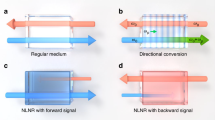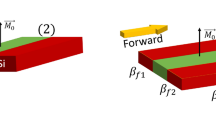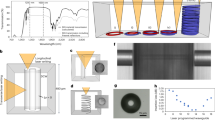Abstract
Wideband optical isolators are critical for the robust operation of virtually all photonic systems. However, they have been challenging to realize in the integrated form due to the incompatibility of magnetic media with these circuit technologies. Here we present the first-ever demonstration of an integrated non-magnetic optical isolator with terahertz-level optical bandwidth. The system comprises two acousto-optic beamsplitters that create a non-reciprocal multimode interferometer exhibiting high-contrast, non-reciprocal light transmission. We dramatically enhance the isolation bandwidth of this system by precisely balancing the group delays of the paths of the interferometer. Using this approach, we demonstrate integrated non-magnetic isolators with an optical contrast as high as 24.5 dB, insertion losses as low as −2.16 dB and optical bandwidths as high as 2 THz (16 nm). We also show that the centre frequency and direction of optical isolation are rapidly reconfigurable by tuning the relative phase of the microwave signals used to drive the acousto-optic beamsplitters. With their complementary metal–oxide–semiconductor compatibility, wideband operation, low losses and rapid reconfigurability, such integrated isolators address a key barrier to the integration of a wide range of photonic functionalities on a chip.
This is a preview of subscription content, access via your institution
Access options
Access Nature and 54 other Nature Portfolio journals
Get Nature+, our best-value online-access subscription
$32.99 / 30 days
cancel any time
Subscribe to this journal
Receive 12 print issues and online access
$259.00 per year
only $21.58 per issue
Buy this article
- Purchase on SpringerLink
- Instant access to full article PDF
Prices may be subject to local taxes which are calculated during checkout



Similar content being viewed by others
Data availability
Further data are available from the corresponding author upon reasonable request. Source data are provided with this paper.
References
Sun, C. et al. Single-chip microprocessor that communicates directly using light. Nature 528, 534–538 (2015).
Shen, Y. et al. Deep learning with coherent nanophotonic circuits. Nat. Photon. 11, 441–446 (2017).
Feldmann, J. et al. Parallel convolutional processing using an integrated photonic tensor core. Nature 589, 52–58 (2021).
Shastri, B. J. et al. Photonics for artificial intelligence and neuromorphic computing. Nat. Photon. 15, 102–114 (2021).
Sipahigil, A. et al. An integrated diamond nanophotonics platform for quantum-optical networks. Science 354, 847–850 (2016).
Mehta, K. K. et al. Integrated optical multi-ion quantum logic. Nature 586, 533–537 (2020).
Moody, G. et al. 2022 roadmap on integrated quantum photonics. J. Phys.: Photon. 4, 012501 (2022).
Roelkens, G. et al. III-V/silicon photonics for on-chip and intra-chip optical interconnects. Laser Photon. Rev. 4, 751–779 (2010).
Shu, H. et al. Microcomb-driven silicon photonic systems. Nature 605, 457–463 (2022).
Rizzo, A. et al. Massively scalable Kerr Comb-driven silicon photonic link. Nat. Photon. 17, 781–790 (2023).
Riemensberger, J. et al. Massively parallel coherent laser ranging using a soliton microcomb. Nature 581, 164–170 (2020).
Li, B., Lin, Q. & Li, M. Frequency–angular resolving LiDAR using chip-scale acousto-optic beam steering. Nature 620, 316–322 (2023).
Chen, R. et al. Breaking the temporal and frequency congestion of LiDAR by parallel chaos. Nat. Photon. 17, 306–314 (2023).
Krause, A. G., Winger, M., Blasius, T. D., Lin, Q. & Painter, O. A high-resolution microchip optomechanical accelerometer. Nat. Photon. 6, 768–772 (2012).
Lai, Y.-H. et al. Earth rotation measured by a chip-scale ring laser gyroscope. Nat. Photon. 14, 345–349 (2020).
Mohanty, A. et al. Reconfigurable nanophotonic silicon probes for sub-millisecond deep-brain optical stimulation. Nat. Biomed. Eng. 4, 223–231 (2020).
Bi, L. et al. On-chip optical isolation in monolithically integrated non-reciprocal optical resonators. Nat. Photon. 5, 758–762 (2011).
Zhang, Y. et al. Monolithic integration of broadband optical isolators for polarization-diverse silicon photonics. Optica 6, 473–478 (2019).
Morichetti, F. et al. Roughness induced backscattering in optical silicon waveguides. Phys. Rev. Lett. 104, 033902 (2010).
Poulton, C. G. et al. Design for broadband on-chip isolator using stimulated Brillouin scattering in dispersion-engineered chalcogenide waveguides. Opt. Express 20, 21235–21246 (2012).
Sounas, D. L. & Alù, A. Non-reciprocal photonics based on time modulation. Nat. Photon. 11, 774–783 (2017).
Williamson, I. A. et al. Integrated nonreciprocal photonic devices with dynamic modulation. Proc. IEEE 108, 1759–1784 (2020).
Lira, H., Yu, Z., Fan, S. & Lipson, M. Electrically driven nonreciprocity induced by interband photonic transition on a silicon chip. Phys. Rev. Lett. 109, 033901 (2012).
Yu, M. et al. Integrated electro-optic isolator on thin-film lithium niobate. Nat. Photon. 17, 666–671 (2023).
Fang, K. et al. Generalized non-reciprocity in an optomechanical circuit via synthetic magnetism and reservoir engineering. Nat. Phys. 13, 465–471 (2017).
White, A. D. et al. Integrated passive nonlinear optical isolators. Nat. Photon. 17, 143–149 (2023).
Sohn, D. B., Örsel, O. E. & Bahl, G. Electrically driven optical isolation through phonon-mediated photonic Autler–Townes splitting. Nat. Photon. 15, 822–827 (2021).
Tian, H. et al. Magnetic-free silicon nitride integrated optical isolator. Nat. Photon. 15, 828–836 (2021).
Herrmann, J. F. et al. Mirror symmetric on-chip frequency circulation of light. Nat. Photon. 16, 603–608 (2022).
Kittlaus, E. A. et al. Electrically driven acousto-optics and broadband non-reciprocity in silicon photonics. Nat. Photon. 15, 43–52 (2021).
Zhou, Y. et al. Nonreciprocal dissipation engineering via strong coupling with a continuum of modes. Phys. Rev. 14, 021002 (2024).
Yang, K. Y. et al. Inverse-designed non-reciprocal pulse router for chip-based lidar. Nat. Photon. 14, 369–374 (2020).
Acknowledgements
This research was developed with funding from the Defense Advanced Research Projects Agency (DARPA LUMOS) under award no. HR0011048577 (H.C., Y.Z., F.R., M.P., S.G., A.L.S., A.J.L., A.T.P., D.C.T., C.D., M.B., K.M.M., M.G., A.K., M.E., A.L.L., N.T.O. and P.T.R.) and the National Science Foundation (NSF) under award no. 2137740.(H.C., Y.Z., F.R., M.P. and P.T.R.) The views, opinions and/or findings expressed are those of the author and should not be interpreted as representing the official views or policies of the Department of Defense, National Science Foundation, or the US Government. Distribution Statement A - Approved for Public Release, Distribution Unlimited. This material is based upon work supported by the Laboratory Directed Research and Development program at Sandia National Laboratories. Sandia National Laboratories is a multi-program laboratory managed and operated by National Technology and Engineering Solutions of Sandia, LLC, a wholly owned subsidiary of Honeywell International, Inc., for the US Department of Energy’s National Nuclear Security Administration under contract DE-NA-0003525. This paper describes objective technical results and analysis. The views, opinions and/or findings expressed are those of the authors and should not be interpreted as representing the official views or policies of the US Department of Energy, US Department of Defense or the US Government.
Author information
Authors and Affiliations
Contributions
H.C., Y.Z., N.T.O., A.L.L. and P.T.R. led the project and conceived of the device physics and experiment. H.C. and Y.Z. designed and measured the dispersion-engineered waveguide devices. Y.Z. and H.C. designed and measured the dual-waveguide devices. F.R., M.P. and S.G. contributed to the AOM design. A.L.S., A.J.L., A.T.P., D.C.T., C.D., M.B., K.M.M., M.G., A.K., A.L.L., M.E. and N.T.O. fabricated the devices. Y.Z., H.C. and P.T.R. wrote the paper with input from all authors. All authors contributed to the design and discussion of the results.
Corresponding authors
Ethics declarations
Competing interests
The authors declare no competing interests.
Peer review
Peer review information
Nature Photonics thanks the anonymous reviewers for their contribution to the peer review of this work.
Additional information
Publisher’s note Springer Nature remains neutral with regard to jurisdictional claims in published maps and institutional affiliations.
Supplementary information
Supplementary Information
Supplementary Sections I–IV, Figs. 1–7, Tables I–III and discussion.
Source data
Source Data Figs. 2 and 3
Statistical source data.
Rights and permissions
Springer Nature or its licensor (e.g. a society or other partner) holds exclusive rights to this article under a publishing agreement with the author(s) or other rightsholder(s); author self-archiving of the accepted manuscript version of this article is solely governed by the terms of such publishing agreement and applicable law.
About this article
Cite this article
Cheng, H., Zhou, Y., Ruesink, F. et al. A terahertz-bandwidth non-magnetic isolator. Nat. Photon. 19, 533–539 (2025). https://doi.org/10.1038/s41566-025-01663-8
Received:
Accepted:
Published:
Issue date:
DOI: https://doi.org/10.1038/s41566-025-01663-8
This article is cited by
-
Forward Brillouin scattering in few-mode fibers
Light: Science & Applications (2025)
-
Harnessing micro-Fabry–Pérot reference cavities in photonic integrated circuits
Nature Photonics (2025)



